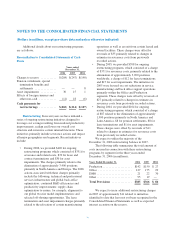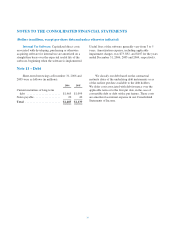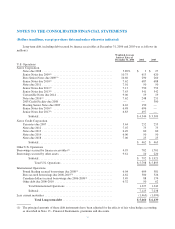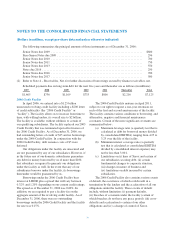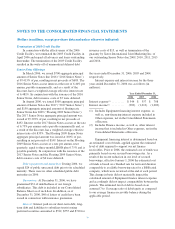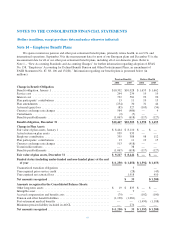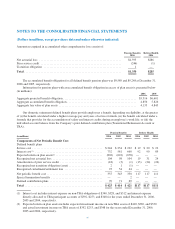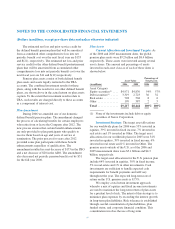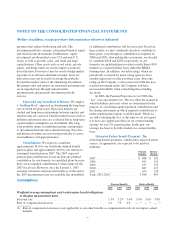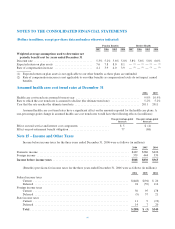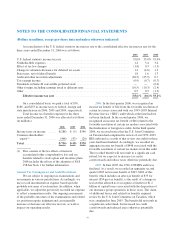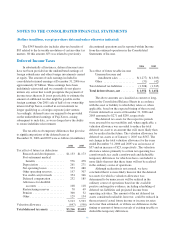Xerox 2006 Annual Report Download - page 85
Download and view the complete annual report
Please find page 85 of the 2006 Xerox annual report below. You can navigate through the pages in the report by either clicking on the pages listed below, or by using the keyword search tool below to find specific information within the annual report.
NOTES TO THE CONSOLIDATED FINANCIAL STATEMENTS
(Dollars in millions, except per-share data and unless otherwise indicated)
forecasted exposures reduce our ability to obtain
hedge accounting. Accordingly, changes in value
for these derivatives are recorded directly through
earnings.
During 2006, 2005, and 2004, we recorded net
currency losses of $39, $5 and $73, respectively. Net
currency losses primarily result from the mark-to-market
of foreign exchange contracts utilized to hedge foreign
currency denominated assets and liabilities, the cost of
hedging foreign currency-denominated assets and
liabilities, the re-measurement of foreign currency-
denominated assets and liabilities and the mark-to-market
impact of economic hedges of anticipated transactions for
which we do not apply cash flow hedge accounting
treatment.
At December 31, 2006, we had outstanding forward
exchange and purchased option contracts with gross
notional values of $1,733. The following is a summary of
the primary hedging positions and corresponding fair
values held as of December 31, 2006:
Currency Hedged (Buy/Sell) (in millions)
Gross
Notional
Value
Fair Value
Asset
(Liability)
U.S. Dollar/Euro ............... $ 119 $ 2
Japanese Yen/U.S. Dollar ........ 228 (5)
Euro/U.S. Dollar ............... 23 —
Canadian Dollar/Euro ........... 173 —
Euro/U.K. Pound Sterling ........ 101 —
Canadian Dollar/U.S. Dollar ...... 151 (1)
Swedish Kronor/Euro ........... 152 4
Japanese Yen/Euro ............. 86 (1)
Euro/Canadian Dollar ........... 85 —
U.K. Pound Sterling/Euro ........ 334 1
Swiss Franc/Euro ............... 124 (2)
All Other ..................... 157 1
Total ........................ $1,733 $ (1)
At December 31, 2006 and 2005, we had
outstanding cross-currency interest rate swap agreements
with aggregate notional amounts of $126 and $127,
respectively. The net liability fair values at December 31,
2006 and 2005 were $9 and $5, respectively. There was
only one contract outstanding at December 31, 2006 and
Japanese Yen was the currency hedged.
Cash Flow Hedges: As of December 31, 2006,
cross currency swaps with a notional amount of $126
were used to hedge the currency exposure for interest
payments and principal on half of our Japanese Yen
denominated debt of ¥30 billion $(252). In addition,
forward currency contracts were used to hedge the
currency exposure for interest payments on the remaining
debt. These combined strategies converted the hedged
cash flows to U.S. dollar denominated payments and
qualified for cash flow hedge accounting.
No amount of ineffectiveness was recorded in the
Consolidated Statements of Income during 2006, 2005 or
2004 for our designated cash flow hedges and all
components of each derivative’s gain or loss was
included in the assessment of hedge effectiveness.
Accumulated Other Comprehensive Loss
(“AOCL”): During 2006, a $1 after-tax decrease in the
fair value of cash flow hedges was recorded in AOCL
while an after-tax amount of $1 was transferred to
earnings as a result of scheduled payments and receipts
on our cash flow hedges. This resulted in an ending gain
position relating to the cash flow hedges in AOCL of $1
as of December 31, 2006.
During 2005, a $32 after-tax decrease in the fair
value of cash flow hedges was recorded in AOCL while
an after-tax amount of $30 was transferred to earnings as
a result of scheduled payments and receipts on our cash
flow hedges. This resulted in an ending gain position
relating to the cash flow hedges in AOCL of $1 as of
December 31, 2005.
Net Investment Hedges: We also utilize non–
derivative financial instruments to hedge against the
potentially adverse impacts of foreign currency
fluctuations on certain of our investments in foreign
entities. During 2006, $1 of net gains related to hedges of
our net investments were recorded in the cumulative
translation adjustment account as a component of
Accumulated other comprehensive loss. We did not have
any net investment hedges in 2005.
83



